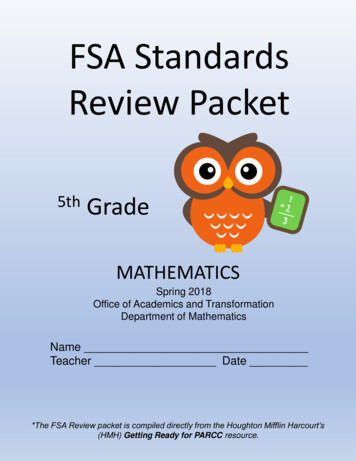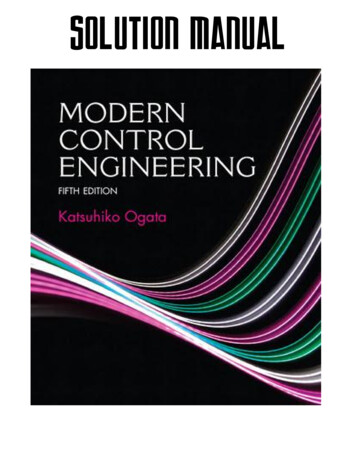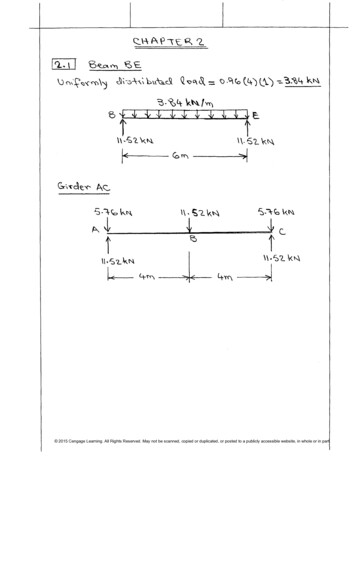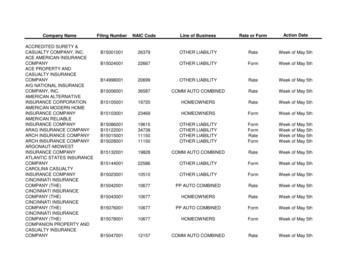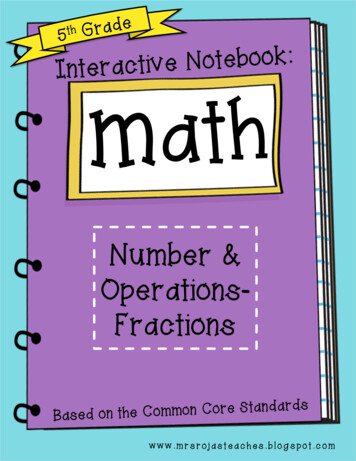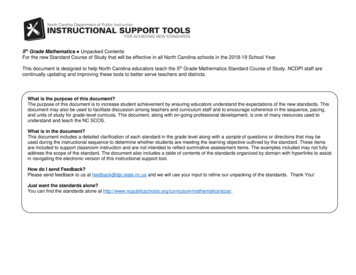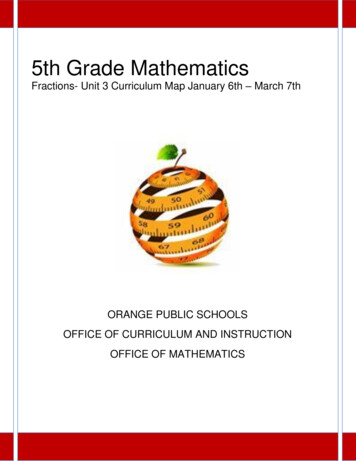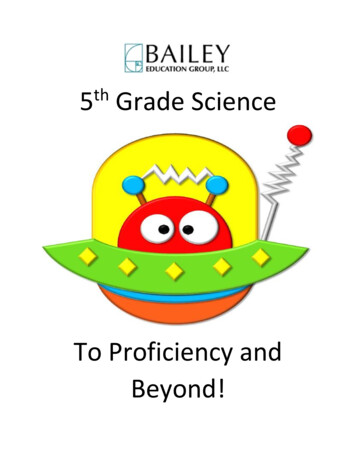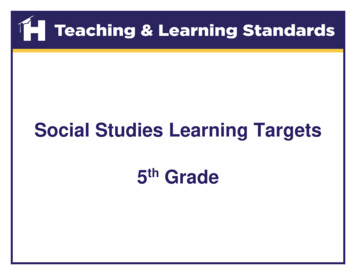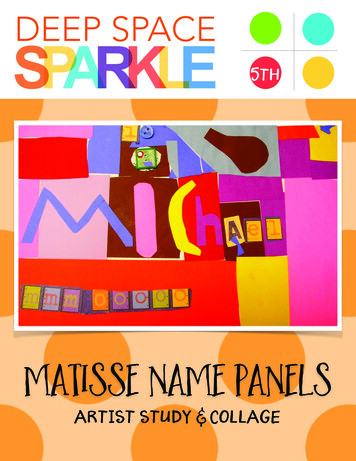
Transcription
DEEP SPACE5thMatisse name panelsartist study & collage
Matisse-InspiredName panelsThis lesson was discovered on the Incredible ArtHere's what You'll Need:by Michelle Peacock of Mohave Middle School.Department website. This lesson was submitted6" x 18" sulphite paperThis is a perfect lesson to do with fifth graders at(regular paper cut in halfthe beginning of the school year: it reinforceshorizontally)names with faces and gets the children warmedSmaller rectangles of coloredup with cutting, pasting, color and composition. Ipaper (solids, crafts, printed,have many posters of Matisse's artwork foretc)inspiration, but if you don't, simply talk about howScissors and glue stickscutting paper can express movement andOptional: buttons, scraps ofemotion.embellished paper, rick rack,You can stick with adding organic and geometricetc.shapes to embellish the artwork or you can addpersonalized details.The Lagoon, 1947 DEEP SPACE SPARKLE/PATTY PALMER 2014. All Rights Reserved.www.deepspacesparkle.com2
About Henri MatisseHenri Matisse was born in 1869 in a small town in France. Hisparents owned a general store and wanted Henri to take over thefamily business but Henri decided to become a lawyer instead. At20, he got very sick and had to admitted to the hospital. Hismother bought him a box of paints and from that day on, Henridecided to be an artist.Matisse was called the “King of Color”. He recognized that colorplayed a big part in how we perceive life. Later in life, Matissedeveloped cancer and was bed ridden. He still created art in hisbed by using a bamboo stick tipped with chalk. He drew on theceiling! He also started cutting out shapes with scissors and calledthis art form, “drawing with scissors.”Did you know That Matisse and Picasso were both friends and rivals? That Matisse joined a group of painters and because of their wildcolors, they were known as “Fauves” which means “wild beasts.” Matisse painted with a few colors and a few lines at a time.A Bird or Two by Bijou Le Tord is my personal favorite book for thislesson. I have quite a few books on Matisse but this one detailsMatisse’s love of color better than the others.As you read the book, point out the wonderful illustrations andthe color choices that the illustrator uses. Notice how Matisseuses complimentary colors in his art as does the illustrator. DEEP SPACE SPARKLE/PATTY PALMER 2014. All Rights Reserved.www.deepspacesparkle.com3
The set-upGive each child a piece of white or colored construction paper. On each table, place scissorsand glue sticks (regular white glue is too messy for this project). At the back of the art room,arrange scrap paper in tin foil trays. Note: This is also a great project to do towards the end ofthe school year when your recycled paper box is very full.Instruct the students to cut out the letters in their name. I demonstrated by reducing a largesheet of paper to smaller rectangles and squares. This way, the letters are easier to cut out. Thiscan be a challenging lesson, and many kids will balk at not using a pencil, but don't give in! Ithink being encouraged to "see" the shape and cutting it is beneficial. Of course, I stress thatany shape, size or style is perfect.We discussed the benefits of cutting all letters out first, then the back ground shapes andplaying with the arrangement before gluing. Some kids will rush this part then be caught havingto pull up their letters. DEEP SPACE SPARKLE/PATTY PALMER 2014. All Rights Reserved.www.deepspacesparkle.com4
The background Shapes1. Select one background coloredpiece of paper and as manysmaller rectangles as there areletters in your name. Set asidesmaller rectangles (letters) fornow.2. Select a few complimentarycolors that are different fromthe letter colors. Cut outORGANIC shapes andbackground shapes. Glue theseshapes to the coloredbackground.3. Often, the NEGATIVE SHAPEthat results from cutting anorganic shape can be used inthe art as well.4. Cut more organic shapes tocover the border of thebackground.5. DEEP SPACE SPARKLE/PATTY PALMER 2014. All Rights Reserved.www.deepspacesparkle.com5
ADDING THE NAME1. Place the name rectangles overthe background art. Trimrectangles so that you get anidea of how big to cut eachletter. Laying out the letters thisway allows children who haveshort or longer names to fit thename onto the background.2. I find it best to cut each letterwithout the use of a pencil butif that is too difficult, show thechildren how to create blockletters. Cut out each letter.Each one needn’t be perfect.some can be small and otherslarge.3. Many children will stop theirartwork after their letters areplaced on the background.to make this project highly personal, ask eachChallenge these students bystudent to cut out symbolic shapes that help defineasking them to add at least 2their personality.GEOMETRIC SHAPES and 2For example, a child who loves hockey, might cutORGANIC SHAPES to theout a pair of skates. A child who loves art, might cutoverall artwork.out a pair of scissors or a brush.Whatever is unique to them, allow them to add thisextra flourish instead of focusing on organic shapes. DEEP SPACE SPARKLE/PATTY PALMER 2014. All Rights Reserved.4.5.www.deepspacesparkle.com6
DEEP SPACE SPARKLE/PATTY PALMER 2014. All Rights Reserved.www.deepspacesparkle.com7
DEEP SPACE SPARKLE/PATTY PALMER 2014. All Rights Reserved.www.deepspacesparkle.com "8
NATIONAL CORE ARTS STANDARDS - fifth gradeCREATINGXGenerate and conceptualize artistic ideas and work — combine ideas to generate aninnovative idea—demonstrate diverse methods to approaching art makingXOrganize and develop artistic ideas and work — experiment and develop skills in multipletechniques through practice—show craftsmanship through care—document objects ofpersonal significanceRefine and complete artistic work—create artists statements using art vocabulary todescribe personal choices in art-makingPresenting/producingAnalyze, interpret and select artistic work for presentation— define roles andXresponsibilities of a curator—explaining the skills/knowledge needed to preform curationDevelop and refine artistic work for presentation — develop a logical argument for safeand effective use of materials and techniques for preparing and presenting artworkConvey meaning through the presentation of artistic work —cite evidence of how anexhibition in a museum presents ideas and provides information about specific conceptsRespondingPerceive and analyze artistic work- compare interpretation of art to another’s interpretationX—analyze cultural associations suggested by visual imageryInterpret intent and meaning in artistic work — interpret art by analyzing form, structure,context information, subject, visual elements, and use of media to identify mood and ideasconveyedApply criteria to evaluate artistic work— recognize differences in criteria used to evaluateworks of art depending on stylesConnectingXSynthesize and relate knowledge and personal experiences to make art- apply formal andconceptual vocabularies of art and design to view surroundings in new ways through artmakingRelate artistic ideas and works with societal, cultural and historical context to deepenunderstanding DEEP SPACE SPARKLE/PATTY PALMER 2014. All Rights Reserved.www.deepspacesparkle.com "9
I can statements for matisse panels Today I will learn about MOVEMENT, so that I CAN create a collage in a style similar to HenriMatisse and use different shapes to give the illusion of movement in the composition. Today I will learn about COMPLIMENTARY COLORS, so that I CAN create a composition with astrong contrast of colors in the letters and background. Today I will learn about SHAPE, so that I CAN demonstrate an understanding of the differencebetween geometric and organic shapes in my work.Common Core STANDARDS for Matisse PanelsCCSS.ELA-Literacy.SL.5.2Summarize a written text read aloud or information presented in diverse media and formats,including visually, quantitatively, and orally.After introducing the students to the artwork of Henri Matisse via posters, children’s book, etc.,students can be asked to answer questions orally to summarize what they have learned aboutMatisse’s style, use of the elements of art, and principles of design in the form of a discussion.CCSS.ELA-Literacy.SL.5.5Include multimedia components (e.g., graphics, sound) and visual displays in presentations whenappropriate to enhance the development of main ideas or themes.By having students create a work of art inspired by Henri Matisse, they are visually developing themain ideas they learned from his style of art making by creating an expressive collage usinggeometric and organic shapes as well as movement.CCSS.ELA-Literacy.RL.5.7Analyze how visual and multimedia elements contribute to the meaning, tone, or beauty of a text(e.g., graphic novel, multimedia presentation of fiction, folktale, myth, poem).After reading the book, A Bird or Two to introduce some of Matisse’s work, you can talk withstudents about how the illustrator used color to contribute to the meaning or tone of the text andmaybe even why certain Matisse compositions were selected for the book. DEEP SPACE SPARKLE/PATTY PALMER 2014. All Rights Reserved.www.deepspacesparkle.com 1"0
Artist StatementYour nameWHAT IS THE NAME OF YOUR ARTWORK?HOW DID YOU CREATE YOUR ARTWORK?(What tools, supplies and techniques did you use?)WHAT DOES THIS PIECE OF ART MEAN TO YOU?(You can use “I” statements and talk about your inspiration and what creatingthis piece of art means to you) DEEP SPACE SPARKLE/PATTY PALMER 2014. All Rights Reserved.www.deepspacesparkle.com 1"1
ASSESSMENT CHECKLISTMain Ideas from:MATISSE NAME PANELSStudent Name:Did the student create movement with theirshapes?Did the student use complementary colors?Did the student include at least 2 geometricshapes and 2 organic shapes in the work?DEEP SPACE SPARKLE & THE MEMBERS CLUB
GEOMETRIC SHAPES and 2 ORGANIC SHAPES to the overall artwork. 4. 5. ADDING THE NAME to make this project highly personal, ask each student to cut out symbolic shapes that help define their personality. For example, a child who loves hockey, might cut out a pair of skates. A child who loves art, might cut out a pair of scissors or a brush.

